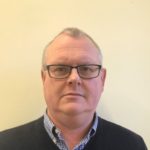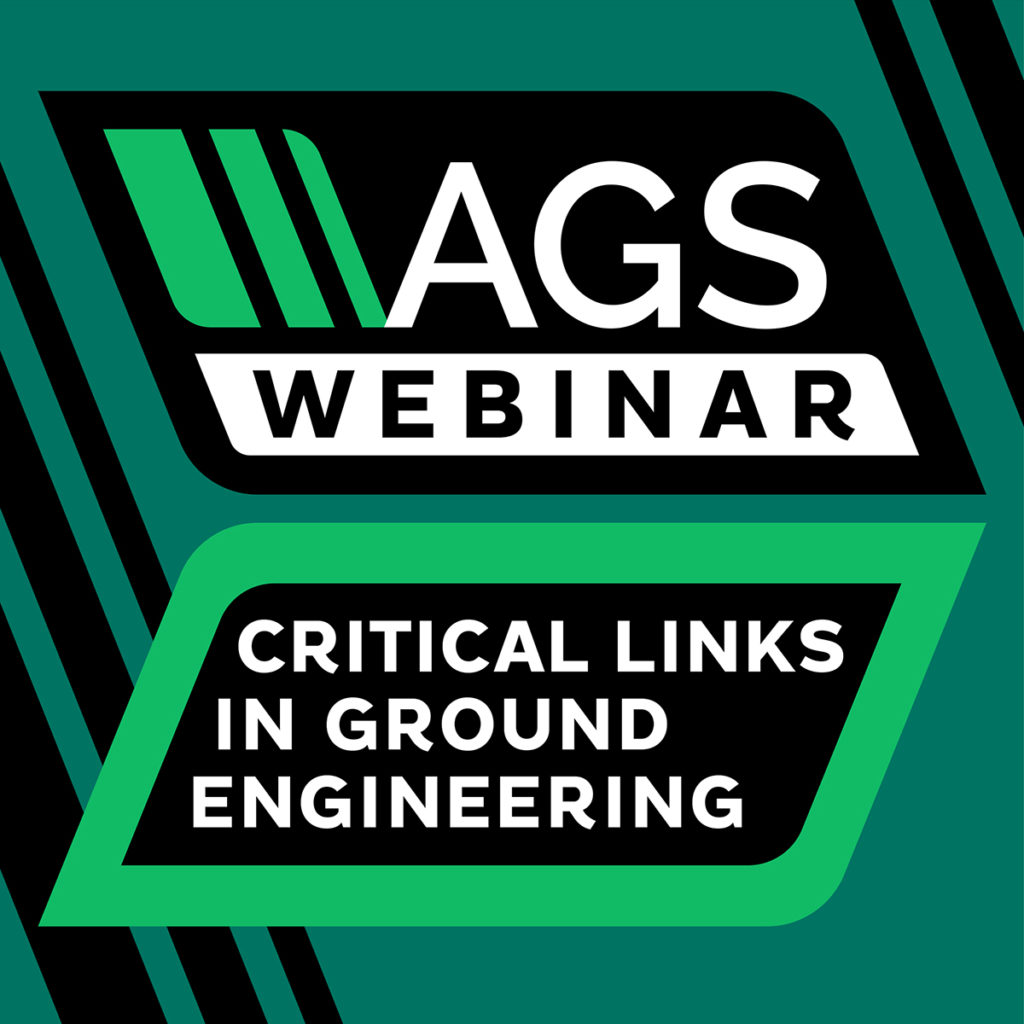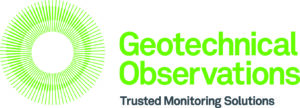Webinar Synopsis
Critical Links in Ground Engineering is the first in a series of events addressing what are considered to be key factors in the process of ground engineering.
In the case of instrumentation and monitoring (I&M), which is the focus area of this webinar, the most critical link is probably that between predicted and actual behaviour of the ground, groundwater regime, temporary works, permanent works, and assets potentially affected by the works.
This Continuing Professional Development (CPD) event will identify and address the hurdles likely to be encountered when setting up an I&M strategy and system, and the provisions that must be made for an effective and meaningful programme. Such provisions include an ability to store the vast amount of data that I&M can generate, and the software necessary to present and assist with the interpretation of that data.
This event will cover a wide range of topics including:
-
- An introduction to instrumentation and monitoring (I&M); the wide range of techniques available and the magnitude of the I&M market.
- The impact of current and forthcoming standards, codes, and specifications on the necessity for, and application of I&M.
- The international dimension to I&M, with reference to practice in New Zealand and Australia.
- The work and global reach of Technical Committees, Steering Groups, and the like, involved in I&M.
- The need for I&M education, training and qualifications for university students, graduates, apprentices and technicians.
- The search for an industry-wide, international, data management system for I&M to complement that already in place for ground investigation (e.g. AGS 4.1 Data Format)
Five, highly experienced speakers will present on a range of topics which are crucial to any ground engineering specialist. They each bring extensive national and international experience of I&M to this webinar, and are highly regarded within their fields. We are pleased to announce that Paul Burton will be joining us as a guest overseas speaker. Paul will be presenting live from New Zealand and will provide an opportunity to compare the application of I&M on an international basis.
Why is instrumentation and monitoring important?
With many projects having the potential to impact unfavourably on the integrity of existing infrastructure and other assets – below, at, or above the ground surface – and the environment, an appreciation of I&M is seen as a critical competence of all those involved with or impacted by such projects.
During construction the behaviour of temporary works demands close I&M attention, especially if there is flexibility in the sequence of work based on the actual behaviour of the temporary works system compared to the predicted behaviour; i.e. when adopting the so-called Observational Method or Approach.
Site conditions can change, especially because of global warming and increased precipitation, and such changes need to be monitored.
Attention to I&M is required in the early stage of a project’s life-cycle, and the application of I&M can extend from Baseline Monitoring – i.e. before construction/implementation, such as during the Ground Investigation – through to post-implementation and possibly demolition or decommissioning.
Who should attend this webinar?
This webinar will address instrumentation and monitoring matters of relevance to geotechnical, geoenvironmental, and environmental specialists, ground engineers, and structural engineers at all levels of experience in the UK and overseas.
It will be relevant to client organisations, consultants, contractors, quantity surveyors, academics and researchers, and to the legal and insurance professions.
Infrastructure owners and owners of buried assets or with assets within the zone of influence of construction works will also benefit from attendance and participation in this webinar.
Presentations
Instrumentation and Monitoring: A Critical Link in Ground Engineering
Presented by Jonathan R A Gammon, (Non-Executive Director / Advisor at Geotechnical Observations Limited and AGS Instrumentation & Monitoring Working Group Leader)
This presentation will identify the role of instrumentation and monitoring (I&M) in ground engineering in its widest sense and will encompass environmental, structural, and asset protection and management considerations.
The status of I&M as a critical link in ground engineering will be illustrated. The importance of I&M in the context of the design and implementation of temporary works, and the related adoption of the Observational Approach/Method, will receive attention.
The presentation will underline the need to give timely attention to I&M and to ensure that adequate provision is made, where appropriate, for the vast amount of data that current I&M systems can generate. The importance of baseline monitoring – i.e. pre-construction or pre-implementation I&M, often included in ground investigation – will be underlined and sources of baseline monitoring data identified. Long-term, extending to whole-life, monitoring also receives attention.
For those unfamiliar with I&M, the presentation will provide a summary of the present-day scope of I&M and the various techniques and types of instrument available. It will include reference to direct and remote monitoring.
The presentation will describe the work of the I&M Working Group which was recently established at AGS as well as introduce the overall content of the Webinar.
Data: Overhead, Deliverable or Opportunity?
Presented by Philip Child, (Senior Consultant, Geotechnical Information Management at Bentley Systems)
The delivery of data, specifically AGS data, is now a staple in many (major) site investigation contracts in the UK. With data unlocking clear benefits for reuse and flexibility it has been known to form the basis for contentious conversations between exchanging parties.
This presentation will outline some key challenges we face but in particular propose an alternative way of thinking about our data. With these fundamentals in place attention will then be given to the specifics of working with monitoring data and the possibilities it provides.
Looking Forwards from Down Below
Presented by Paul Burton, (Executive Leader at Geotechnics, New Zealand)
Providing instrumentation and monitoring services in the Australasian region can be challenging. This presentation will share and highlight these challenges and look to suggest some developments that could benefit the world community of I&M professionals.
The presentation will provide an overview of the types of projects and solutions encountered in the Antipodes. In a globalized world, does it matter that you are in a remote island in the South Pacific? Does it matter that you are in a diametrically opposite time zone? What are the effects of limited international travel? Using some case studies, this presentation will bring some sunshine to the Northern Hemisphere winter.
Development of International Standards for Instrumentation and Monitoring
Presented by Dr Andrew Ridley, (Managing Director at Geotechnical Observations Limited)
International standards for geotechnical monitoring have been in development by ISO since 2010. The first of these on general rules was published in 2015 and is currently being reviewed. Part 2 on extensometers was published in 2016, Part 3 on inclinometers was published in 2017, Part 5 of Total Strs Cells was published in 2019 and the latest standard Part 4 on piezometers was published in 2020. All of these have been published as ISO Standards in English and French worldwide.
In Europe the standards have been published under EN_ISO 18674 and a German language version has also been published. Standards on strain gauges, load cells and settlement systems are in preparation.
This presentation will highlight the content of the Standards that have been published.
What might a Qualified Technician look like?
Presented by Julian Lovell, (Managing Director at Equipe Group and AGS Chair)
This presentation will discuss the UK’s strategy to develop training for installation and monitoring technicians which dovetails in with the development of Vocational Qualifications and compliance to the Standards.
Currently, the training of individuals who carry out installation and monitoring activities hugely varies and is often ad hoc. As clients are becoming increasingly aware of the importance of monitoring their geotechnical assets and structures and the complexity of some of the instrumentation equipment and associated technology grows it is essential that technicians and ground practitioners are equipped with the knowledge and skills to perform the work assigned to them.
This is an opportunistic time to develop a joined-up strategy, as new International Standards are being discussed which set out the competence requirements of a Qualified Technician and the AGS is also leading a Working Party developing a brand-new Vocational Qualification for field and laboratory technicians.
Sponsors
Geotechnical Observations Limited
Geotechnical Observations is a leading provider of instrumentation and monitoring services. They supply and install all forms of structural and geotechnical instrumentation, collect data and provide assistance, when required, to understand the results using its Geodaisy® software. They are the exclusive distributor of ShapeArrays in the UK and Ireland.
RST Instruments
For over 40 years, RST’s technologies have enabled iconic infrastructure projects, including ground-breaking mines, tunnels and more. We’ve grown a reputation for solutions that span the lifecycle of your project, from designing and building to training, installing, inspecting and updating monitoring systems. That’s a legacy worth protecting.
www.rstinstruments.com/
Senceive
We lead the world in the design, manufacture and continuous improvement of wireless condition monitoring technology. Our precise, durable and robust products are engineered in direct response to the demands of rail, construction and mining environments. By providing repeatable, high quality data on the structural and geotechnical condition of assets, we empower our clients to proceed with confidence.
Measurand
Measurand designs and manufactures ShapeArray, the only patented monitoring instrument of its kind. Used for mining projects as an integral part of the monitoring strategy, this automated, inclinometer-style instrument has set a new standard for ease of installation and data collection.
www.measurand.com/
Geosense
Geosense is a leading UK manufacturer of instrumentation for the geotechnical, structural, mining and environmental industries.
Established in 1992, Geosense specialises in vibrating wire and MEMS sensors, which are used to produce a wide range of instruments. In addition, the company manufactures automated data acquisition systems, including wireless systems.
Speakers

Non-Executive Director / Advisor at Geotechnical Observations Limited and AGS Instrumentation & Monitoring Working Group Leader
Jonathan Gammon, having retired in 2017, was appointed Non-Executive Director and Advisor Geotechnical Observations Limited in 2018.
He continues to be a Chartered Civil Engineer and Chartered Geologist and has almost 45 years of international construction experience working for consultants and contractors in the UK, Europe, Africa, the Middle East and beyond. His experience encompasses the specification, procurement, and implementation of instrumentation and monitoring, together with the acquisition, management, and interpretation of data.
Jonathan project experience includes Design Manager and Resident Engineer for West Rail in Hong Kong and Sub-Surface Design Manager for the Reference Design of Dublin Metro North in Ireland. His experience in London includes Crossrail, Thameslink (Blackfriars Station Redevelopment), Tideway Tunnels, and the Northern Line Extension. He was Design Project Manager for the Bond Street Station Upgrade before working on Phase One of the High Speed Two railway between London and Birmingham.
He is a UK Representative on the ISSMGE’s Technical Committee TC220 (Field Measurement in Geomechanics).

Senior Consultant, Geotechnical Information Management at Bentley Systems
Philip has over 20 years’ experience working with geotechnical software in various capacities. A contributor to the work of the data management and instrumentation & monitoring working groups he is passionate about effective coaching and training.
Philip has a keen interest in a particular aspect of data – the very human process of interacting with it.

Executive Leader at Geotechnics (New Zealand)
Paul entered the Geotechnical field in 1996 and has continued to develop both his career and the industry over the past 24 years. Paul started as a graduate engineer in the UK and after a year moved to New Zealand. Paul has developed his career from Instrumentation technician through to his current Executive Leader and Board roles for the largest Geotechnical Consultancy in New Zealand.
Alongside his career development, Paul has always been involved in industry development organisations, starting with Area representative roles for NZGS and ACE NZ, developing them through to become a Board member for ACE NZ. Paul also led the inception and Chaired CETANZ, a new organisation specifically for the Civil Engineering Testing profession.
In more recent times Paul has been a proponent for the development of ISSMGE – TC220 (Field Monitoring in Geomechanics), in an international setting, working to build on the foundations set through a series of conferences, and is currently the secretary for this organisation.

Managing Director at Geotechnical Observations Limited
Andrew Ridley is the Managing Director of Geotechnical Observations Ltd (GeO), which he founded in 2000. GeO specialise in the installation, reading, reporting and interpretation of geotechnical instrumentation.
Andrew obtained his first degree in Civil Engineering from the University of Nottingham in 1984, followed it with a Master’s Degree in Soil Mechanics from Imperial College London in 1988 and was awarded a PhD by Imperial College in 1993 for his work on “the measurement of soil moisture suction.”
He has served on the Editorial Panel of Geotechnical Engineering (the proceedings of the ICE), the Editorial Panel of Géotechnique for the 2011 Symposium in Print on Partial Saturation in Compacted Soils, the Steering Committee for CIRIA 550 Infrastructure Embankments – Condition Appraisal and Remedial Treatment and represents FMGM (Field Measurements in Geomechanics) on the BGA (British Geotechnical Association) committee. He is also the UK representative on ISO/TC182/WG2, which is drafting International Standards for geotechnical instrumentation and monitoring and is Chair of ISSMGE TC220 on Field Measurements in Geomechanics.
In 2016 he was awarded the John Mitchell Gold Medal by the Institution of Civil Engineers in recognition of his contributions to geotechnical engineering.

Managing Director a Equipe Group and AGS Chair
Julian is the current Chair of AGS and has been involved in the geotechnical industry for over 30 years. He is actively involved in producing safety and technical guidance for the industry and sits on British and European committees. He is also Managing Director of Equipe which is the UK’s leading provider of vocational training and assessment. Julian is currently working with UGUK to ensure geoscience training meets the industry needs.
Price: £108.00
AGS Member: £72.00 inc. VAT

